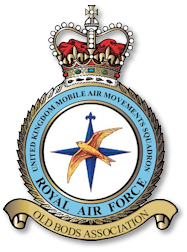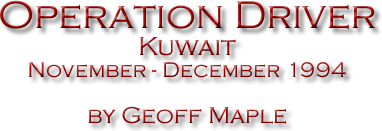


The Kuwait of October 1994 is a very different place to that of August 1991. The Kuwaitis have become used to the street place Americanisation of MacDonalds and Pizza Hut. They have settled into an interest in capitalism and freedom that only an occupation and a deprivation could bring. The country and her western allies had become somewhat used to Iraq suffering silently under United Nations sanctions. Until that is, morning editions of the Arab Times between the 15th and 10th October 1994 graphically described the swift movement of Iraq’s Republican Guard and Army towards the border with Kuwait. So close were the Iraqis at one moment, that they were less than 10 miles from Kuwait. Suddenly the prosperity and passion for capitalism and America was again threatened. People were walking around the souk actively remembering where the public air raid shelters were and Kuwait City became a city under siege; road blocks, armed roving patrols and an air of fear and suspicion. The American garrison permanently based in the UN camp at Doha were already alert and priming their reserves for another Desert Storm. But would the other western allies respond? After the swift response of August 1990 from the British, we were surely bound to contribute again. From the other Gulf States the UAE sent troops and ships to Kuwait.
Eventually the UK made a commitment; 45 Commando and it’s complete support elements of the Cdo Logs Regt and 29 Cdo RA amongst the most prominent. Once again it would fall upon RAF Lyneham to play its key role in the immediate deployment. It seemed that once again the experts in rapid deployment to out-of-area operations came from the flying squadrons and UKMAMS.
Saddam Hussein timed his advance to Kuwait perfectly. His major fear must have been that RAF Lyneham and UKMAMS were primed and ready for action. He must have calculated that with their commitments to Spilt (Op Grapple), Ancona (Op Cheshire) and Gioia del Colle (Op Deny Flight), Incirlik (Op Warden), Dhahran (Op Jural), Rwanda (Op Gabriel) plus exercise Red Flag in the States and on top of all that preparation and participation in TACEVA, we would surely be too preoccupied and over stretched to worry about him. Again Saddam miscalculates!
On 11th October 1994 UKMAMS was again called to support what had been known as Operation Driver. Because 45 Cdo were based in Arbroath, Scotland, a team was deployed to RAF Leuchars for the outload under Flt Lt Andy Hulls and Flt Lt Dave Nattras.
The Leuchars team consisted of FS Bruce Oram, Sgt George Quarless and 4 lads from the shift contingency teams. Therefore the aircraft flew from Lyneham to Leuchars and then with their mainly wheeled loads into Kuwait via Akrotiri with a crew change and to be met by UKMAMS at Kuwait International Airport. The deputy air transport detachment commanded was Flt Lt John Poulson, RAFLO Bahrain.
The MAMS teams went into a 12-hour shift system. The night shift was consisted of Flt Lt Andy State and Sgts Paddy Power, Ted Edwards and Karl Hibbert, Cpl Dave Clancy, SAC Paul Hunt, Yorky Booth and Tony Fowler. The first aircraft to arrive in Kuwait with UKMAMS on board was Tristar KC1 from Edinburgh. The aircraft was also carrying elements of 45 Cdo and ATLO staff. It was not the first time that UKMAMS and arrived in Kuwait since the end of Op Granby, so handling a KC1 was no problem. The Kuwait Air Force have 2 main deck transfer loaders (FMC) and Kuwait Airways have a mountain of handling aids plus the Americans have too much kit and always seem happy to help out. On the 14th October the remainder of UKMAMS arrived in theatre on a Hercules and the 12-hour shift deployment swung into action. The day shift consisted of Flt LT Geoff Maple with FS Colin Rowland, Sgt John Purkiss, Cpls Dick Nurse and Simon Gill, SACs Geordie Walton, Carl King, Robbie Collins, Deano Richardson and Steve Hughes. This brought the total of UKMAMS in Kuwait to 18.
The deployment consisted of a Hercules every 2 hours and a Tristar every 12 - in theory. However, on average, throughout the day a C130 would arrive every 45 minutes and on most days the KC1’s would only be 6 hours apart. But on the 19th October during the day there were 3 Hercules, 1 KC1 (in 20-pallet fit) and an HS125 on the ground at once. During the night of 20th October there were 2 KC1’s within 3 hours of each other. A major concern was the empty pallets and nets had to be returned so a credible system was worked out with the Cdo Logs who would break down the pallets in the desert and then return them to the airhead on the same flat bed 40 foot trailers. This system worked extremely well and only took a total of 3 hours from offloading to seeing the pallets being returned to the airport. The days generally consisted of moving from an aircraft to untangling nets, to an aircraft and back to nets. We all kept going thanks to the cups of tea supplied by each loadie. It was half an hour for each C130 but what seemed like all day for the pallets and nets! However, on the 20th October we had some help from Flt Lt Andy Marshall who arrived on a Tristar and announced that we were going to ‘Tacevaled’. Here we were on a real operation and thousands of miles from Lyneham and still not immune from a Taceval. All went well and Andy left 12 hours later.
The deployment of Op Driver finished on the 22nd October and UKMAMS Kuwait had offloaded 126 aircraft with a total of 3,142,247lbs of freight, 339 vehicles and 1263 pax. Not forgetting that UKMAMS loaded these aircraft at either Lyneham, Leuchars or Edinburgh. The re-supply schedule has become one Tristar KC1 a week which allows for 49 pax and 12 pallets if freight, which is shared with Dhahran on Op Jural. To handle these flights, the UKMAMS detachment of Flt Lt Geoff Maple, FS Colin Rowlands and SAC Geordie Walton and Yorkie Booth have remained.
However, it has not been all work, there are numerous moments from the deployment, Firstly, the ATLO drove the from South Cerney to Arbroath to catch their C130 for Kuwait when Lyneham is only 45 minutes drive away, it took them 12 hours. We’ve also been joined at the Airport by a detachment from the Cdo Logs Regt, who brilliantly set up their 12 x 24 foot tent as the 45 Cdo airhead; until a USAF Galaxy taxied past their tent it looked great. It is now a pile of canvass with a number of tent poles.
The detachment is still in full swing (at the time of writing) so we’ve had a an average of 2 aircraft a day, mostly HS125 and a Tristar KC1 and C130. Added to this we’ve helped Kuwait Airways load a B727 full freighter for Bombay and we presented Kuwait Airways with a Squadron print for their excellent support.
Looking back over the detachment it was interesting to note that while we were still in the full throws of arriving, the Iraqis had pulled back towards Baghdad and the Americans were going home also. Op Driver is now an exercise, which may come to an end sometime in early December 1994.
Kuwait City is back to normal. No road blocks or searches. The weather has become cooler and when it rains - it pours and there are no drains. There is no beer either and no bars. But there is UKMAMS and we’re still here.


